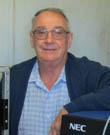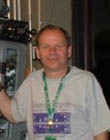|
|
This topic comprises 2 pages: 1 2
|
|
Author
|
Topic: Question About 1916 (!) Projector
|
|
|
|
|
|
|
|
|
|
|
|
|
|
|
|
|
|
|
|
|
|
|
|
|
Simon Wyss
Film Handler

Posts: 80
From: Basel, BS, Switzerland
Registered: Apr 2011
|
 posted 04-05-2014 01:51 AM
posted 04-05-2014 01:51 AM




quote: Leo Enticknap
the technology was essentially invented by Elmer Sperry in the early teens
Sperry stole the invention from Heinrich Beck (b. September 20, 1878, d. August 17, 1937). Deutsches Reichspatent, number 262913, to Körting & Mathiesen, Inc. of Leutzsch-Leipzig, September 13, 1910. A perfectly working prototype was presented to the German navy in 1912.
Beck got stuck in the U. S. A. at the outbreak of the war and could only return home in 1920. The American patents were sold to GE.
http://www.becklaser.de/heinbeck/hbeckframeset.html
| IP: Logged
|
|
|
|
|
|
|
|
All times are Central (GMT -6:00)
|
This topic comprises 2 pages: 1 2
|
Powered by Infopop Corporation
UBB.classicTM
6.3.1.2
The Film-Tech Forums are designed for various members related to the cinema industry to express their opinions, viewpoints and testimonials on various products, services and events based upon speculation, personal knowledge and factual information through use, therefore all views represented here allow no liability upon the publishers of this web site and the owners of said views assume no liability for any ill will resulting from these postings. The posts made here are for educational as well as entertainment purposes and as such anyone viewing this portion of the website must accept these views as statements of the author of that opinion
and agrees to release the authors from any and all liability.
|

 Home
Home
 Products
Products
 Store
Store
 Forum
Forum
 Warehouse
Warehouse
 Contact Us
Contact Us




 Printer-friendly view of this topic
Printer-friendly view of this topic










![[Wink]](wink.gif)








